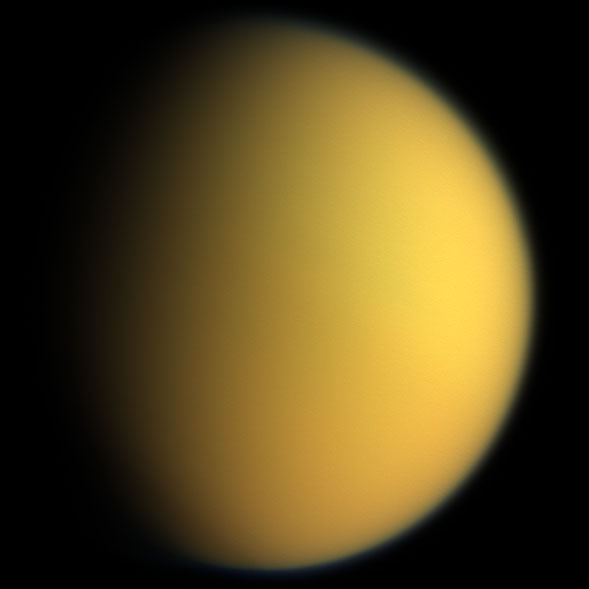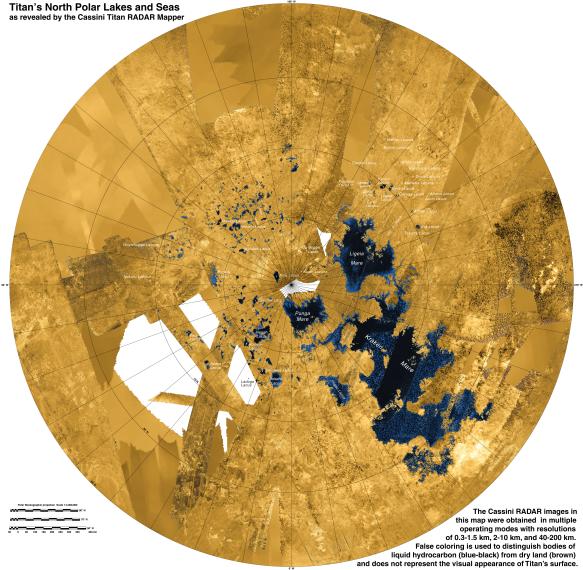
The Cassini mission has been orbiting Saturn since 2004, weaving in and among its moons and rings, and now we have this image taken on Saturn’s large moon Titan on August 21, 2014. It shows the mouth of a flooded river valley on Titan, which is a moon completely shrouded by clouds, whose surface has been revealed only by Cassini’s radar. During this recent flyby, the craft used radar to sound the depths of the largest of Titan’s methane/ethane seas. This sea on Saturn’s moon – called Kraken Mare – was discovered in 2007 by Cassini and named for a legendary sea monster. Cassini’s Titan flyby on August 21 included a segment designed to collect altimetry (or height) data, using the spacecraft’s radar instrument, along a 120-mile (200-kilometer) shore-to-shore track on Kraken Mare. For a 25-mile (40-kilometer) stretch of this data, along the sea’s eastern shoreline, Cassini’s radar beam bounced off the sea bottom and back to the spacecraft, revealing the sea’s depth in that area to range from 66 to 115 feet (20 to 35 meters).
These new findings are being presented this week at the Division for Planetary Sciences Meeting of the American Astronomical Society held in Tucson, Arizona.
Read more about Cassini’s August 21 flyby of Titan, from JPL


The mosaic just above, created by Cassini via many flybys of Titan over nearly a decade, shows the seas of Titan in context. Be sure to click on the larger, labeled image to see which sea are which. NASA said of this image:
This colorized mosaic from NASA’s Cassini mission shows the most complete view yet of Titan’s northern land of lakes and seas. Saturn’s moon Titan is the only world in our solar system other than Earth that has stable liquid on its surface. The liquid in Titan’s lakes and seas is mostly methane and ethane … The data were obtained by Cassini’s radar instrument from 2004 to 2013. In this projection, the north pole is at the center. The view extends down to 50 degrees north latitude. In this color scheme, liquids appear blue and black depending on the way the radar bounced off the surface. Land areas appear yellow to white.
Kraken Mare, Titan’s largest sea, is the body in black and blue that sprawls from just below and to the right of the north pole down to the bottom right. Ligeia Mare, Titan’s second largest sea, is a nearly heart-shaped body to the left and above the north pole. Punga Mare is just below the north pole.
The area above and to the left of the north pole is dotted with smaller lakes. Lakes in this area are about 30 miles (50 kilometers) across or less.
Most of the bodies of liquid on Titan occur in the northern hemisphere. In fact nearly all the lakes and seas on Titan fall into a box covering about 600 by 1,100 miles (900 by 1,800 kilometers). Only 3 percent of the liquid at Titan falls outside of this area.
It’s very interesting to remember that, before Cassini, we had never peered through Titan’s clouds and had no idea these seas of liquid – albeit liquid methane and ethane – existed. Now we not only know they exist, but we have also sounded their depths. It’s a stunning achievement and yet another illustration of the power of robot spacecraft!
Bottom line: The Cassini spacecraft – which has been orbiting Saturn since 2004 – used radar to sound the depths of a sea of liquid methane and ethane on Saturn’s large moon Titan.











